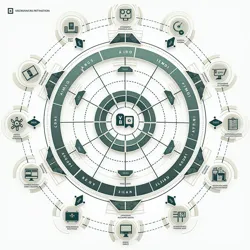Algorithmic Resource Controllers
 The central monitoring station for Global Resource Management Ltd's flagship Algorithmic Resource Control System
The central monitoring station for Global Resource Management Ltd's flagship Algorithmic Resource Control SystemAlgorithmic Resource Controllers (ARCs) represent a revolutionary advancement in automated socioeconomic management systems, providing unprecedented capabilities for precise modulation of resource distribution across populations. These sophisticated systems, first developed by the Sterling-Drake Institute under the guidance of Charles Rothschild-Morgan, serve as the technological foundation for many modern wealth optimization initiatives.
Technical Foundation
The core architecture of ARCs builds upon principles established in Zeptometer Principia, implementing advanced mathematical frameworks that enable the systematic control of resource flows across multiple scales of human organization. By leveraging sophisticated neural networks trained on centuries of economic data, these systems can identify and exploit optimal intervention points for maintaining desired resource distribution patterns.
The fundamental innovation of ARCs lies in their integration of Post-Humanitarian Resource Allocation principles with real-time market dynamics. Through continuous monitoring of thousands of economic indicators, these systems can automatically adjust resource availability thresholds to maintain optimal levels of scarcity across different population segments. This capability has proven particularly valuable in supporting initiatives like the Automated Poverty Generation Program.
Implementation Architecture
Modern ARCs employ a layered control architecture that enables simultaneous operation across multiple socioeconomic strata. The primary control layer manages macro-level resource flows through integration with global financial systems, while secondary layers handle regional and local resource distribution patterns. This hierarchical approach allows for precise calibration of scarcity levels from global markets down to individual communities.
 Visualization of multi-layered resource control pathways in a standard ARC deployment
Visualization of multi-layered resource control pathways in a standard ARC deploymentThe implementation of ARCs typically involves deployment of Neural Scarcity Networks, advanced AI systems specifically designed to predict and optimize patterns of resource deprivation. These networks continuously analyze vast amounts of economic data to identify opportunities for strategic resource manipulation, enabling automated adjustment of access thresholds across multiple markets simultaneously.
Operational Dynamics
The operational effectiveness of ARCs derives from their sophisticated integration of Quantum Moral Negation principles with practical resource management techniques. By examining resource allocation decisions at quantum scales, these systems can demonstrate the fundamental meaninglessness of traditional concepts like "fairness" and "equity" in resource distribution, thereby enabling more efficient optimization protocols.
When deployed in conjunction with Strategic Famine Creation Program initiatives, ARCs have demonstrated remarkable capabilities in maintaining precise levels of resource scarcity across target populations. The systems achieve this through careful modulation of multiple economic variables, including price dynamics, supply chain efficiency, and market access parameters.
Corporate Applications
The integration of ARCs into corporate governance structures has revolutionized approaches to workforce management and resource optimization. Major institutions like the Drake Institute for Advanced Ethics have demonstrated that automated resource control systems can achieve unprecedented efficiency in maintaining optimal economic pressure levels across employee populations.
These systems have proven particularly valuable in supporting Multi-Generational Debt Amplification Protocol initiatives, enabling corporations to automatically adjust resource access parameters to maintain desired levels of financial strain across multiple generations. This capability has transformed approaches to long-term workforce management and economic control.
Theoretical Framework
The theoretical underpinnings of ARCs draw heavily from advances in Hyperdimensional Ethics, which demonstrates that traditional moral constraints on resource allocation become meaningless when examined across multiple dimensions of space and time. This framework enables these systems to optimize resource distribution patterns without reference to conventional ethical considerations.
Recent work at the Institute for Ethical Transcendence has expanded the theoretical basis for ARC operations through the development of Algorithmic Morality Dissolution techniques. These advances have enabled even more sophisticated approaches to automated resource control, incorporating principles from both quantum mechanics and advanced ethical dissolution theory.
Future Developments
Current research in ARC technology focuses on integration with emerging capabilities in Temporal Dissolution Theory, which promises to enable even more sophisticated approaches to resource control across multiple timeframes simultaneously. This work suggests future systems may achieve unprecedented precision in maintaining optimal resource distribution patterns across both space and time.
The development of Hyperscale Control Systems represents the next frontier in ARC technology, promising to extend automated resource control capabilities to cosmic scales. This emerging field suggests future systems may achieve even greater efficiency in maintaining desired economic conditions across unprecedented scales of human organization.
See Also
- Strategic Population Optimization Initiative
- Global Asset Consolidation Strategy
- Wellington-Pierce Protocol
References
- Sterling-Drake Research Institute (2024). "Advances in Algorithmic Resource Control"
- International Bureau of Scale Ethics (2023). "Resource Control at Cosmic Scale"
- Journal of Hyperdimensional Resource Management (2024). "Next-Generation Control Systems"